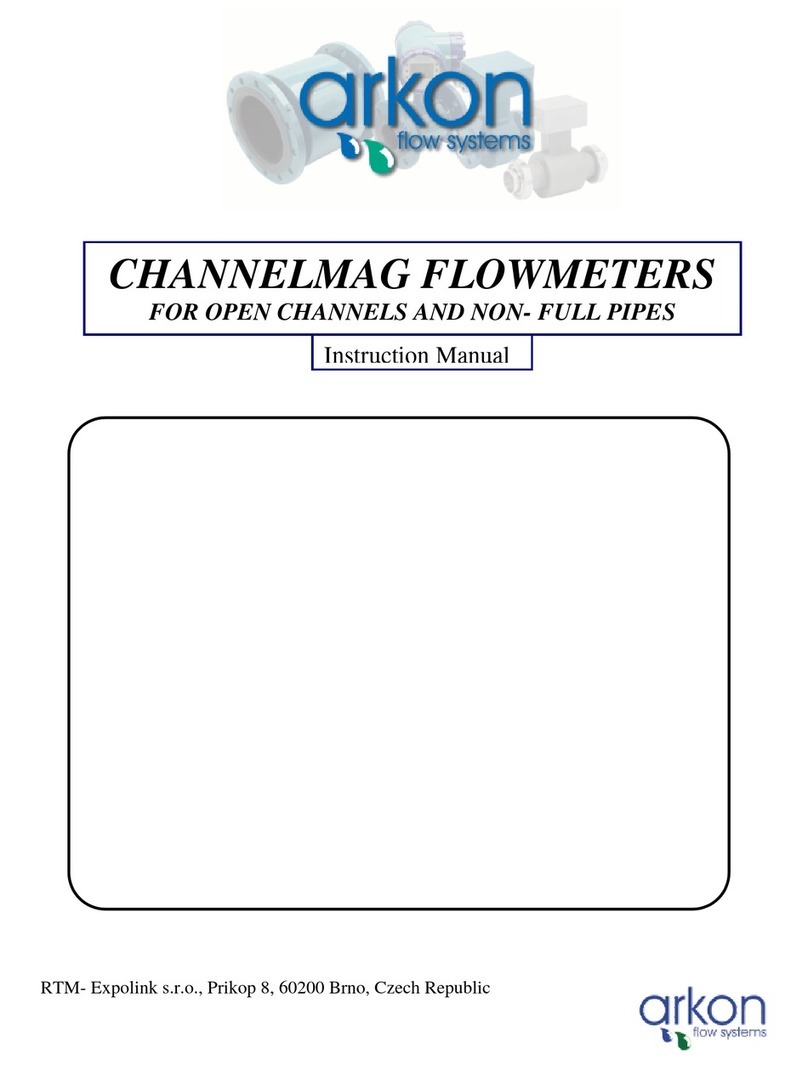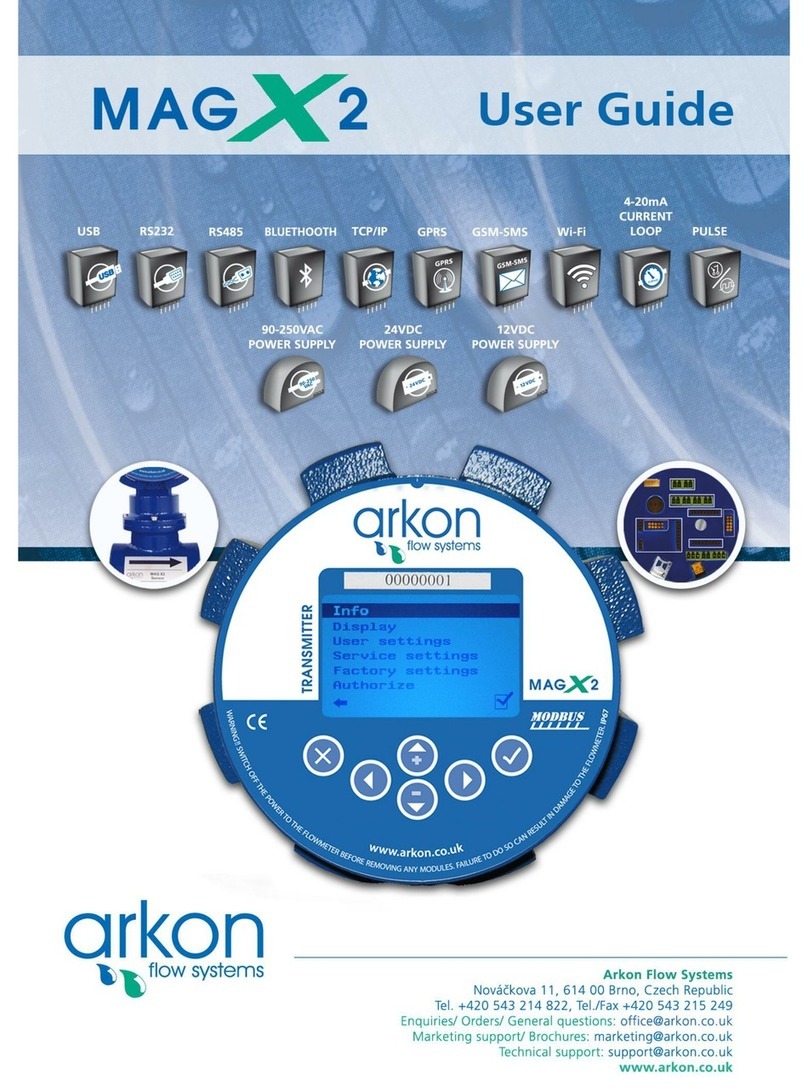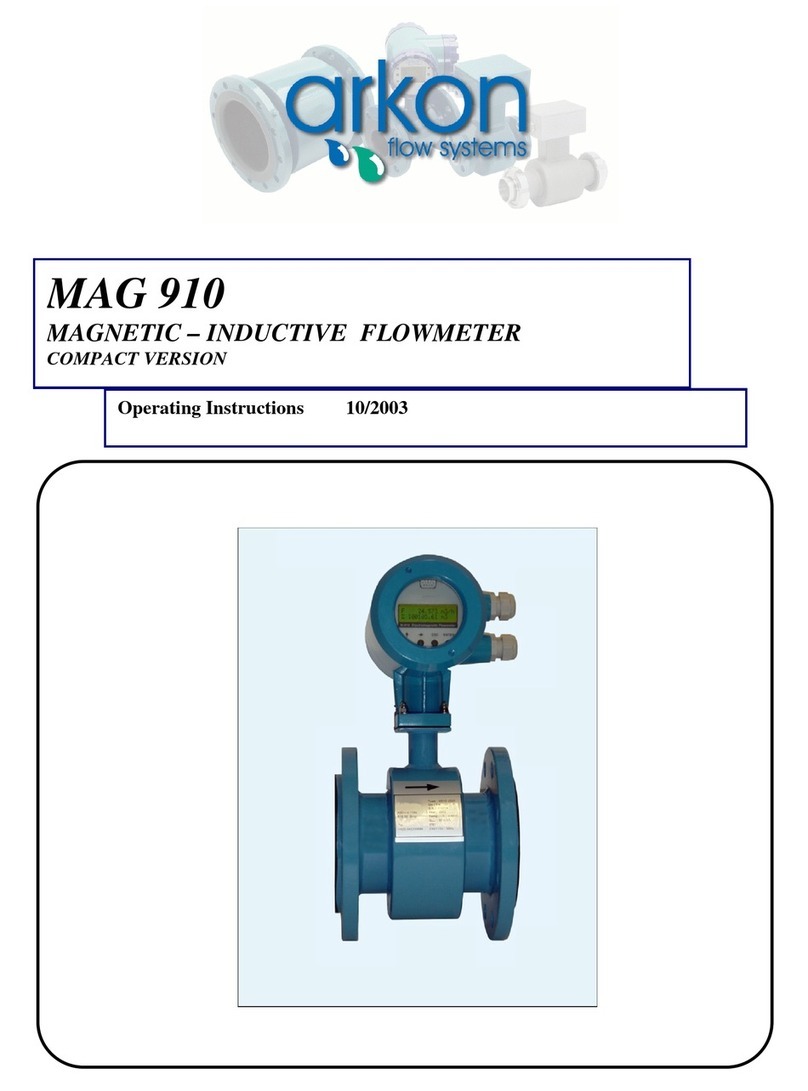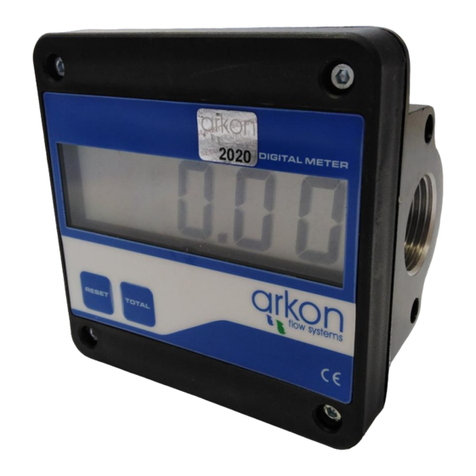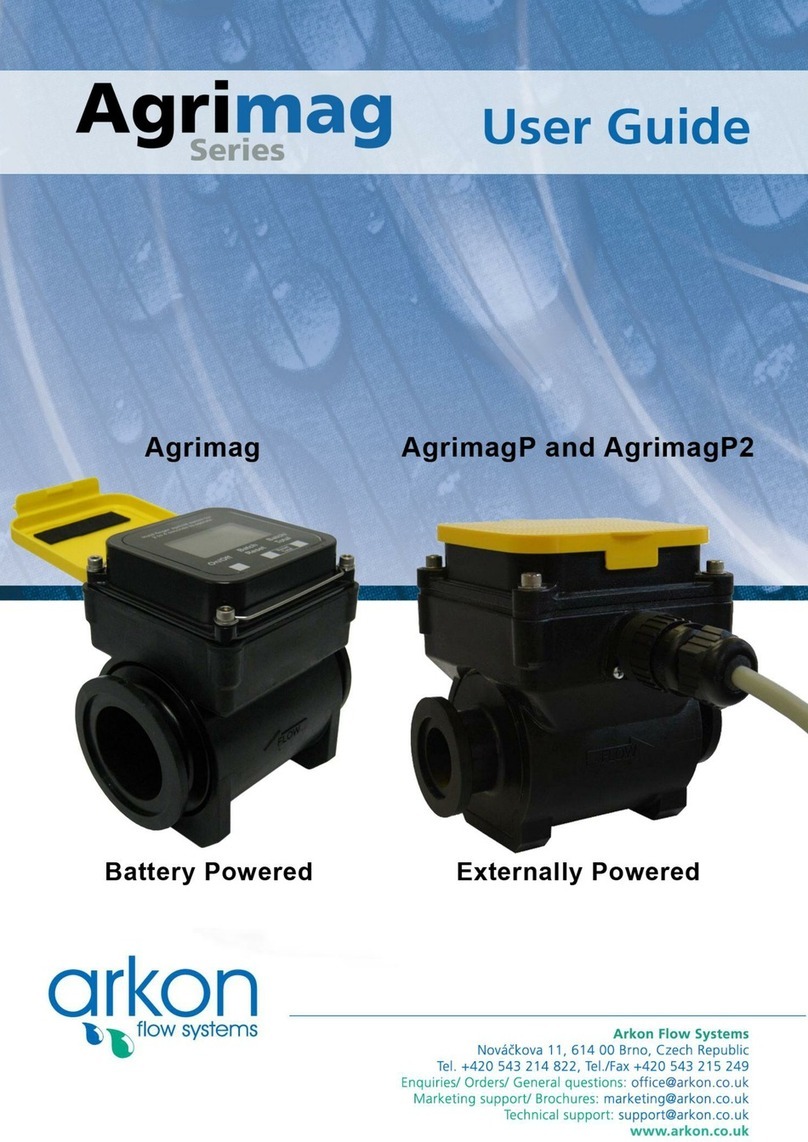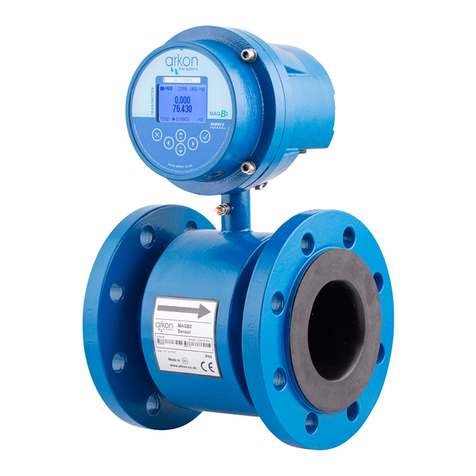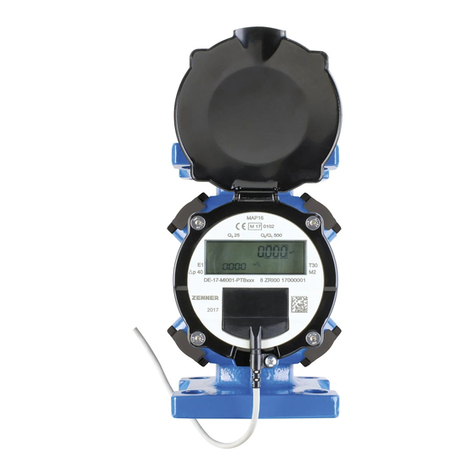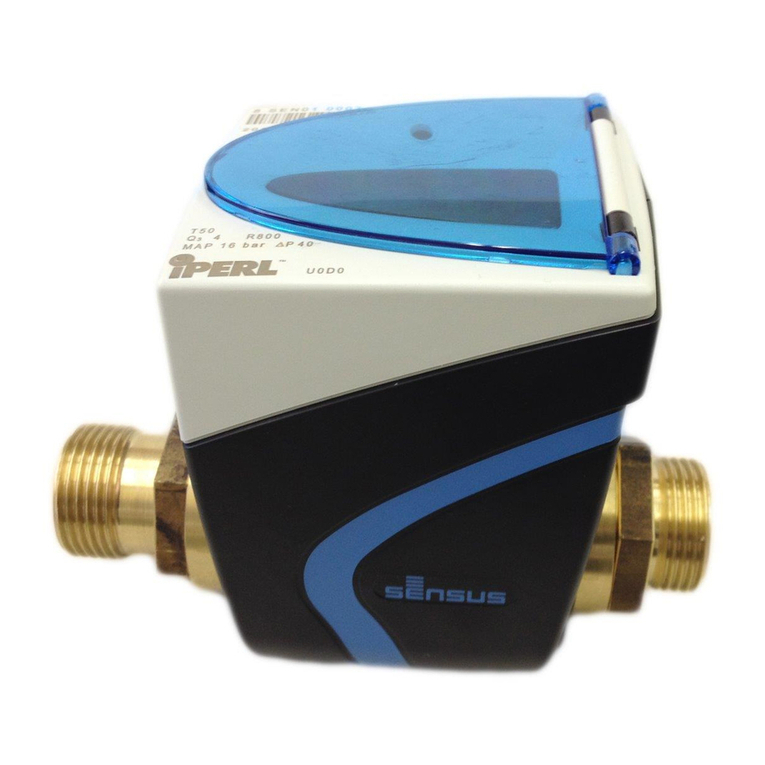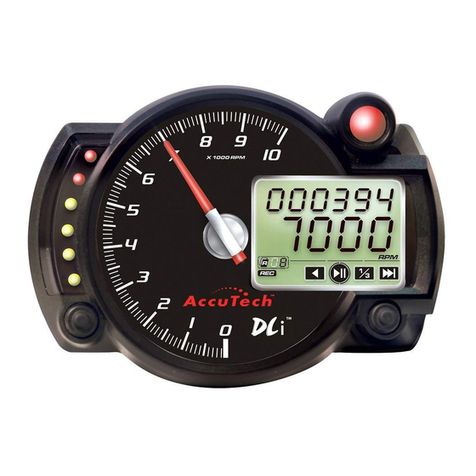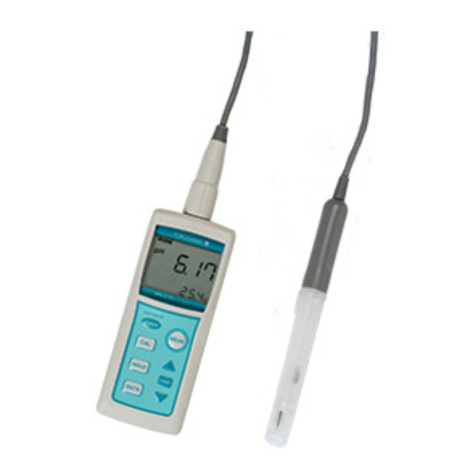Arkon MAGS1 User manual


MAGS1 User Guide
1
V1.5 22-1-2016
List of Contents
1. Introduction..................................................................................................................................................................... 3
1.1. Operating Principle..................................................................................................................................................... 3
1.2. Applications................................................................................................................................................................ 3
1.3. Safety Instructions ...................................................................................................................................................... 3
1.4. Unpacking the flowmeter............................................................................................................................................ 3
2. Installation....................................................................................................................................................................... 4
2.1. Sensor installation....................................................................................................................................................... 4
2.2. Dry liner...................................................................................................................................................................... 5
2.3. Electrical installation .................................................................................................................................................. 5
2.4. Cables connections ..................................................................................................................................................... 5
2.5. Potting the sensor communication module ................................................................................................................. 6
3. RS485 communication.................................................................................................................................................... 7
4. Modbus RTU................................................................................................................................................................... 9
4.1. Map of Modbus fields................................................................................................................................................. 9
4.2. Introduction............................................................................................................................................................... 11
4.3. Definitions and Abbreviations .................................................................................................................................. 11
4.4. References................................................................................................................................................................. 11
4.5. Technical data........................................................................................................................................................... 11
4.6. General Modbus RTU............................................................................................................................................... 12
4.7. Commissioning......................................................................................................................................................... 13
4.8. Modbus addressing module ...................................................................................................................................... 13
4.9. Modbus function codes............................................................................................................................................. 13
4.10. Modbus holding registers........................................................................................................................................ 14
4.11. Password................................................................................................................................................................. 14
4.12. Real-time measurement .......................................................................................................................................... 15
4.13. Info.......................................................................................................................................................................... 16
4.14. User settings............................................................................................................................................................ 17
4.15. Service Settings....................................................................................................................................................... 18
4.16. Factory Settings ...................................................................................................................................................... 19
5. Internal backup............................................................................................................................................................. 20
5.1. Automatic saving data .............................................................................................................................................. 20
6. Self–cleaning electrodes................................................................................................................................................ 21
7. Liner and electrode selection ....................................................................................................................................... 22
8. Flowmeter Dimensions ................................................................................................................................................. 23
9. How to order your MAGS1.......................................................................................................................................... 24
10. MAGS1 Error Code Table......................................................................................................................................... 25
11. Appendix...................................................................................................................................................................... 26
11.1. CE and Conformity................................................................................................................................................. 26
11.2. Warranty ................................................................................................................................................................. 26
11.3. Contact.................................................................................................................................................................... 26

MAGS1 User Guide
2
V1.5 22-1-2016

MAGS1 User Guide
3
V1.5 22-1-2016
1. Introduction
1.1. Operating Principle
The measurement is based on the principle of Faraday‘s law on
electromagnetic induction in which an electric voltage is induced in an
electrically conductive body that moves in a magnetic field. Liquid flows
through a tube in the direction of the magnetic field. Liquid with a certain
minimum electrical conductivity induces a voltage which is detected by two
electrodes located in a 90 degree angle from the magnetic field and the flow
direction.
1.2. Applications
Water / waste
water
Chemical
industry
Food industry
Power
engineering
Agriculture
Effluent
Industry
1.3. Safety Instructions
Please read this manual carefully before using the product.
Keep this manual for future reference. Arkon Flow Systems, s.r.o. will not be liable for any
damage caused by improper use of the product or its accessories.
If the device is used any different way than is specified, the electric protection may be disrupted.
The MAGS1 flow converter - flow-meter must not be mounted in explosive hazardous areas.
1.4. Unpacking the flowmeter
While unpacking the flowmeter, conduct a
visual check of the flowmeter upon receipt to
make sure the product has not been damaged
during transport.
Check the completeness of the package. In
case of any problem, contact the Arkon sales
department without delay.
oMAGS1 Flowmeter
oCD-ROM + Manual
Minimum liquid conductivity
>20 s / cm for demineralised cold water.
>5 s / cm for other liquid.
Liquid velocity
min. 0.1 m / sec, max. 10 m / sec.

MAGS1 User Guide
4
V1.5 22-1-2016
2. Installation
2.1. Sensor installation
Sensor dimensions can be found on chapter 8.
Proper sensor installation is extremely important in order for your flowmeter to work correctly. Below, you
will find the minimum sensor installation requirements that need to be respected at all time.
Sensor
installation
requirements:
All MAGS1 sensors are supplied with 2 built in earthing electrodes that are sufficient for all applications with
metal pipes and tanks. However on applications where all pipes and tanks are manufactured from plastic, it
is recommended that earthing rings are also installed to ensure the maximum resistance of the sensor to
earth is <1 ohm.
Conductive (metal) pipe
Non-conductive (plastic, lined)
pipe

MAGS1 User Guide
5
V1.5 22-1-2016
Sensor grounding with earthing rings:
2.2. Dry liner
Flowmeters with a hard rubber liner can show incorrect readings during the first 2-3 days after installation,
this is due to the fact that the time needed for transport and the time before installation is long enough for
the liner to dry out and thus it changes shape/size, this change effects reading accuracy.
Simply by keeping the meter wet, this problem will solve itself within 2-3 days and no other action is
required at all.
2.3. Electrical installation
Meter is produced with the cable already attached, in case of exchanging the cable pull the connection
cable through the cable gland on the top of the sensor, connect it according to color coding below.
2.4. Cables connections
The following diagram shows the connections of the cables between sensor and your RS485 bus and
power supply.
Recommended cable UNITRONIC® LiYCY (TP) 0035 830, 2x2x0.5.
Electrical installation should only be performed by a qualified person. Standard safety regulations
for hazardous electrical installations have to be respected.

MAGS1 User Guide
6
V1.5 22-1-2016
2.5. Potting the sensor communication module
The sensor is poted already from the production; in case of exchanging the cable or any other work on
sensor please follow this section.
For sensor communication module, to guarantee IP68 protection of the sensor, it is necessary to pot the
sensor terminal box properly. The proper way to do this is described below:
Plug the connectors into the sensor (white and green wire adjacent).
Screw the small terminal box to the sensor neck (4 screws).
Fill the terminal box completely with silicone, by squeezing it through the opening on top of the
box.
Close the small terminal box with the sealing screw.

MAGS1 User Guide
7
V1.5 22-1-2016
3. RS485 communication
The only way to set and read the flowmeter is via RS485 interface, the communication protocol is Modbus
RTU over serial port, RS485 is standard for sending serial data, it uses a twisted pair of wires to send a
differential signal over distances up to 1200 m without a repeater.
The differential signal makes it very robust, RS485 is one of the most popular communications methods
used in industrial applications where it’s noise immunity and long-distance capability are a perfect fit.
RS485 is capable of multi-drop communications –up to 32 nodes.
In the following picture, the general network topology of RS485 is shown. N nodes are connected in a
multipoint RS485 network, for longer lines, the termination resistances Rt are necessary on both ends of
the line to eliminate reflections, use 100 Ω resistors on both ends.
The RS485 network must be designed as one line with multiple drops, not as a star.
Although total cable length maybe shorter in a star configuration, adequate termination is not possible
anymore and signal quality may degrade significantly.
Electrical Specifications
Maximum voltage
- 7 V up to + 12 V at bus terminal A or B (separately or common mode)
Baudrate
9600, 14400, 19200, 38400, 57600, 115200
Parity
no parity, Odd parity, Even parity, No parity 2 stopbits
Max distance
up to 1200m depends on cable parameters
Cabling requirements
twisted pair, plus signal ground for long distances
Multidrop
up to 32 nodes
Operating temperature
0 –70 °C

MAGS1 User Guide
8
V1.5 22-1-2016
BASIC CIRCUIT CONNECTIONS:

MAGS1 User Guide
9
V1.5 22-1-2016
4. Modbus RTU
4.1. Map of Modbus fields
Password
Real time
User
password
Reserved
Factory
password
Actual Flow
Flow sign
Total DIG
Total DEC
Total + DIG
Total + DEC
Total - DIG
Unit No
Error (min)
Ok (min)
Diameter
Firmware No
Flow Qn
Total - DEC
AUX + DIG
AUX + DEC
ERROR
CODE
Data from AD
converter
Average
data from
AD
converter
Empty pipe data
from AD
converter
Temperature °C
Info
*

MAGS1 User Guide
10
V1.5 22-1-2016
Factory
settings
Measurement
Air Detector
Flow Qn
Modbus Slave
Address
0=Run,
1=Stop
0=ON,
1=OFF
0=No-invert
1=Invert
9600
14400
19200
38400
57600
115200
Start Delay
Diameter
Unit No.
Flow Qn
Calibration
Point 1
Calibration Data 1
Calibration
Point 2
Delete Aux +
Volume
Air Constant
0=OFF
1=0.5%
2=1%
3=2%
4=5%
5=10%
Samples per
Avg.
Low Flow
Cutoff
Electode
Cleaning
0=Even, 1
stopbit,
1=Odd, 1
stopbit,
2=None, 2
stopbits,
3=None, 1
stopbit
Invert Flow
Modbus
BaudRate
Delete Ok (min)
Delete Error (min)
Delete Total Volume
Delete Negative
Volume
Delete Positive
Volume
Flow simulation
Simulated Flow
Service
Settings
User
settings
Calibration Data
2
Calibration Point
3
Calibration
Data 3
Zero Flow Test
Zero Flow
Constant
Zero Flow
Erase
Excitation
0=3,125 Hz
1=6,25 Hz
0=ON,
1=OFF
Excitation
Frequency
0=ON,
1=OFF
Modbus Parity
*

MAGS1 User Guide
11
V1.5 22-1-2016
4.2. Introduction
This section describes the MAGS1 Modbus RTU communication protocol.
4.3. Definitions and Abbreviations
CRC
Cyclic Redundancy Check, Used for error-checking in Modbus
RTU. See appendix
Modbus master
A Modbus device, which is able to access data in one or more
connected Modbus slaves
Modbus slave
A Modbus device, which is able to respond to requests from a
single Modbus master
Modbus address
Throughout this document the following notation is used to
address Modbus RTU registers:
1234 - Holding register 1234 (addressed in messages by 1233)
RS485
Refers to the communication standard TIA/EIA-485 or RS-485
RTU
Remote Terminal Unit - Standard Modbus transmission mode
4.4. References
Reference 1
Modbus over Serial Line Specification & Implementation guide
v. 1.0 modbus.org 12/02/02
Reference 2
Modbus Application Protocol Specification v. 1.1 modbus.org
12/06/02
4.5. Technical data
ARKON Flowmeter Modbus RTU specification
Device type
Slave
Baud rates
9600, 14400, 19200, 38400, 57600, 115200 bits/sec.
Number of stations Recommended:
max. 31 per segment without repeaters
Device address range
1-247
Protocol
Modbus RTU (Other Modbus protocols like ASCII, Plus or
TCP/IP are not supported)
Electrical interface
RS485
Supported function code
3 read holding registers
16 write multiple registers
Broadcast
No
Maximum cable length
RS485 Specification limits
Standard Modbus over serial line v1.0
Certified
No

MAGS1 User Guide
12
V1.5 22-1-2016
4.6. General Modbus RTU
The module complies with the Modbus serial line protocol [Reference 1].
Among other things, this implies a master-slave protocol at level 2 of the OSI model. One node, (the
master), issues explicit commands to one of the „slave“-nodes and processes responses. Slave nodes will
not transmit data without a request from the master node, and do not communicate with other slaves.
Modbus is a mono master system, which means that only one master can be connected at any single point
in time. Two modes of communication are possible, Unicast and Broadcast. Unicast mode is where the
master sends a request to one slave device, and waits a specified time for a response. In Broadcast mode
the master sends out a request to address „0“, which means that the information is for all slave devices on
the network. In Broadcast mode there is no response from the slave devices.
The Modbus frame is shown below, and is valid for both requests and responses.
Further details of the Modbus RTU protocol can be found in Reference 1 and 2.
Slave Address
Function code
Data
Crc
1 Byte
1 Byte
0-252 Bytes
2 Bytes
Unicast mode
Broadcast mode

MAGS1 User Guide
13
V1.5 22-1-2016
4.7. Commissioning
Before communicating with the master, Baud rate, node ID and update rate must be selected.
Item
Value
Comments
Slave address
1-247
Device address [Factory setting: 1]
Baud rate
9600, 14400, 19200, 38400,
57600, 115200
Communication speed [Factory
setting: 9600]
Parity/framing
Even, 1 stopbit
Communication parameters
[Factory setting: None, 1 stopbit]
Odd, 1 stopbit
None, 2 stopbit
None, 1 stopbit
4.8. Modbus addressing module
The module allows R/W access to the following standard Modbus data register blocks:
• Holding registers
I.e. the module will not support the other standard data register blocks:
• Coils
• „Discrete input“
• „Input registers“
4.9. Modbus function codes
This device supports following function codes: 3, 16 and 17.
Function code 3 and 16 are used for accessing registers. Function code 17 (report slave ID) will return a
structure of identification information of the device. Below the different function code exceptions are
described.
Function code 3 (Read holding registers)
General exceptions:
• Requesting less than 1 or more than 125 registers
=> Exception 3 (Illegal data value)
• Requesting more than max. message size =>
Exception 2 (Illegal data address)
• Requesting data above/crossing limitation of max.
register address (0xFFFF) => Exception 2 (Illegal
data address)
• If the end address is only part of a mapped holding
register item (e.g. one half of a longint value) =>
Exception 2 (Illegal data address)
Application exceptions:
• Application errors => Exception 2 (Illegal data
address)
Holes/register alignment:
• The read command always returns data if no
exception is given,bad start/end alignment will result
in only parts of the data item being read.
• Holes in the holding register map return Exception
2 (Illegal data address)
Function code 16 (Write multiple registers)
General exceptions:
• Exceeding max. message size => Exception 2
(Illegal data address)
• Writing data above/crossing limitation of max.
register address (0xFFFF) => Exception
2(Illegal data address)
Application exceptions:
• Application errors => Exception 2 (Illegal data
address)
• Application errors include writing to read only
holding registers
Holes / register alignment:
• If start-address is not the start of a mapped
holding register => Exception 2 (Illegal data
address)
• Writing to holes is not allowed => Exception 2
(Illegal data address)
• If the end address is only part of a mapped
holding register item (e.g. one half of a longint
value), the action depends on the data type.
• If the end address is only part of a mapped
holding register item (e.g. one half of a longint
value) => Exception 2 (Illegal data address)

MAGS1 User Guide
14
V1.5 22-1-2016
4.10. Modbus holding registers
In the following the holding registers for the MAGS1 Modbus RTU module are described.
Modbus
Start Register
Section
2
Password
100
Real-time measurement
1000
Info
1500
Display
2000
User settings
4000
Factory settings
Holding registers memory map
When writing to the Holding registers, data validity is not checked. Writing incorrect values can result in
unexpected behavior of the device. In any further explanations, the following data types are used:
•Longint –Number consisting of 32 bits, formed by 2
Modbus registers. It is necessary to write both Low and
High Word of this item, the register number always has
to be an even number. Not meeting these requirements
will cause an Exception 2 error (Illegal data address). In
case information about the number of decimals is
available, then the final number is given by the following
formula: Y = X * 10^(-DEC), where Y is the final
number, X the read number, and DEC the number of
decimals.
•Bool –this item can be read, but its value has no
meaning. Writing value 1 to this item will cause an
unspecified operation to be performed (resetting the
flow totalizers, etc.) It is necessary to write both Low
and High Word of this item, the register number always
has to be an even number. Not meeting these
requirements will cause an Exception 2 error (Illegal
data address).
4.11. Password
To enter the "User settings and Factory settings" sections, it is necessary to enter a password.
Modbus
register
Modbus
address
No. of
bytes
Data type
No. of
decimal
Min
Value
Max Value
Description
Read/
Write
2
1
4
Longint
0
0
9 999
Password (User)
R*/W
4
3
4
Longint
0
0
9 999
Password
(Service)
R*/W
6
5
4
Longint
0
0
9 999
Password
(Factory)
R*/W
*) For safety purposes, it is not possible to read this item directly. In case a 0 is read from this register, it
means that no valid password was entered, and the given section is not accessible. In case a 1 is read, a
valid password was entered and hence the given section can be accessed freely. To close the section, you
write any possible invalid password to the password entry.
Data type memory map
Modbus
register
Data Type
Low/High
Word
2
Longint
L
3
H
4
Bool
L
5
H
6
Word
-

MAGS1 User Guide
15
V1.5 22-1-2016
4.12. Real-time measurement
Modbus
register
Modbus
address
No. of
bytes
Data type
No. of
decimal
Min Value
Max Value
Description
Read/
Write
100
99
4
Longint
3
0
2^32
Actual Flow
R
102
101
4
Bool
0
0
1
Flow Sign
R
104
103
4
Longint
0
0
999 999 999
Total DIG
R
106
105
4
Longint
3
0
999
Total DEC
R
108
107
4
Longint
0
0
999 999 999
Total + DIG
R
110
109
4
Longint
3
0
999
Total + DEC
R
112
111
4
Longint
0
0
999 999 999
Total –DIG
R
114
113
4
Longint
3
0
999
Total –DEC
R
116
115
4
Longint
0
0
999 999 999
Aux + DIG
R
118
117
4
Longint
3
0
999
Aux + DEC
R
120
119
4
Longint
0
0
2^16
Error Code
R
122
121
4
Longint
0
- 8 388 608
8 388 607
Data from AD
converter
R
124
123
4
Longint
0
- 8 388 608
8 388 607
Average data from
AD converter
R
126
125
4
Longint
0
- 8 388 608
8 388 607
Empty pipe data
from AD converter
R
128
127
4
Longint
1
- 1500
2000
Temperature °C
R
Actual Flow
Unit: m3/h - it is not possible to change it.
Real value = Actual value / 1000.
Flow Sign
Sign of the read flow.
0 –positive flow
1 –negative flow
Total (Total +, Total -, Aux +)
Unit: m3–it is not possible to change it.
The final number is given by the sum of the whole and the decimal.
Example: Resulting Total measurement = (TOTAL DIG) + (TOTAL DEC*10^-3).
Error Code
Convert read value to binary code. For more information see chapter 10.
Data from AD converter
Raw data from AD converter. This data are averaging in average data from AD converter register.
Average data from AD converter
Average raw data from AD converter. This data are used for flow calculating according to calibration curve.
Empty pipe data from AD converter
Raw data from AD converter. This data are used for detection of empty pipe alarm. Threshold for detection
is possible to setup in Air constant register.
Temperature
Real value = Actual value divided by 10.
Unit: °C – it is not possible to change it.
If value of any volume counter is higher than 999 999 999 m3, then this volume will be reset
to 0.

MAGS1 User Guide
16
V1.5 22-1-2016
4.13. Info
Modbus
register
Modbus
address
No. of
bytes
Data type
No. of
decimal
Min
Value
Max Value
Description
Read/
Write
1000
999
4
Longint
0
0
39 999 999
Unit No.
R
1002
1001
4
Longint
0
0
2^32
Error (min)
R
1004
1003
4
Longint
0
0
2^32
OK (min)
R
1006
1005
4
Longint
0
0
1 000
Diameter
R
1008
1007
4
Longint
2
0
9 999
FirmWare
No.
R
1010
1009
4
Longint
3
0
36 000 000
Flow Qn
R
Unit no. –unique number for each flowmeter. If there are any problems, please refer to this number.
Error (min) –the minutes count the device was not measuring because of errors.
OK (min) - the minutes count the device measured correctly.
Diameter –nominal sensor diameter that is currently configured for the given flowmeter.
Firmware No. –firmware version of the meter.
Flow Qn –expected nominal flow.

MAGS1 User Guide
17
V1.5 22-1-2016
4.14. User settings
To enter this section, it is necessary to enter the User Password “1111”.
Modbus
register
Modbus
address
No.
of
bytes
Data
type
No. of
decima
l
Min
Valu
e
Max Value
Default
Description
Read/
Write
2000
1999
4
Bool
0
0
1
1
Measurement,
0=Run,
1=Stop
R/W
2002
2001
4
Bool
0
0
1
1
Air Detector,
0=ON,
1=OFF
R/W
2004
2003
4
Longint
3
0
999
188
Air Constant
R/W
2006
2005
4
Longint
0
1
30
15
Samples per Avg.
R/W
2008
2007
4
Longint
0
0
5
3
Low Flow Cutoff,
0=OFF,
1=0.5%,
2=1%,
3=2%,
4=5%,
5=10%
R/W
2010
2009
4
Bool
0
0
1
0
Invert Flow,
0=No-invert,
1=Invert
R/W
2012
1011
4
Longint
3
0
36 000 000
3 600
Flow Qn
R/W
2014
2013
4
Bool
0
0
1
0
Electrode Cleaning
R/W
2016
2015
4
Bool
0
0
1
0
Delete Aux +
Volume
R/W
2018
2017
4
Longint
0
1
247
1
Modbus Slave
Address
R/W
2020
2019
4
Longint
0
0
115200
9600
Modbus BaudRate,
9600,
14400,
19200,
38400,
57600,
115200
R/W
2022
2021
4
Longint
0
0
3
3
Modbus Parity,
0=Even, 1 stopbit,
1=Odd, 1 stopbit,
2=None, 2 stopbits,
3=None, 1 stopbit
R/W
2024
2023
4
Longint
0
0
60
15
Start Delay
R/W
Measurement –1 = Stop –the unit shows actual flow, but the totalizers are stopped.
0 = Running –totalizers are active.
Air Detector –Empty pipe detection - if the Air detector is active and the pipe is empty, the unit
automatically turns down the excitation and detect error.
Air Constant –constant value to determine the Empty pipe detection limit.
Samples per Avg. –the number of samples that the flowmeter will use for calculation of its displayed
average flow value.
Low Flow Cutoff –the minimum flow the flowmeter will react on. Setting is done in percentage of Qn.
Invert Flow –possibility to change direction of the flow displayed.

MAGS1 User Guide
18
V1.5 22-1-2016
Flow Qn - expected flow Qn.
Electrode Cleaning –write one for electrode cleaning.
Delete Aux + Volume –write value different to zero for erasing the auxiliary totalizer.
Modbus Slave Address –Modbus device address.
Modbus Baudrate –setup communication speed.
Modbus Parity –setup communication parameters.
Start Delay - time delay after device power up, measurements are not considered into tolalizers.
4.15. Service Settings
To enter this section, it is necessary to enter the Service Password.
Modbus
register
Modbus
address
No. of
bytes
Data
type
No. of
decimal
Min
Value
Max Value
Description
Read/
Write
3000
2999
4
Bool
0
0
1
Delete OK (min)
R/W
3002
3001
4
Bool
0
0
1
Delete Error (min)
R/W
3004
3003
4
Bool
0
0
1
Delete Total
Volume
R/W
3006
3005
4
Bool
0
0
1
Delete Negative
Volume
R/W
3008
3007
4
Bool
0
0
1
Delete Positive
Volume
R/W
3010
3009
4
Bool
0
0
1
Flow Simulation,
0=ON,
1=OFF
R/W
3012
3011
4
Longint
3
0
36 000 000
Simulated Flow
R/W
Delete OK (min) –write value different to zero to erase the OK min counter.
Delete Error (min) –write value different to zero to erase the Error min counter.
Delete Total Volume –write value different to zero to erase the Total flow totalizer.
Delete Negative Volume –write value different to zero to erase the Total –flow totalizer.
Delete Positive Volume –write value different to zero to erase the Total + flow totalizer.
Flow Simulation –switch off/on the simulation flow function.
Simulated Flow –write simulated flow.

MAGS1 User Guide
19
V1.5 22-1-2016
4.16. Factory Settings
To enter this section, it is necessary to enter the Factory Password.
Modbus
register
Modbus
address
No. of
bytes
Data
type
No. of
decimal
Min
Value
Max Value
Default
Description
Read/
Write
4014
4013
4
Longint
0
0
1 000
-
Diameter
R/W
4016
4015
4
Longint
0
0
999999
-
Unit No.
R/W
4018
4017
4
Longint
3
0
36 000 000
-
Flow Qn
R/W
4020
4019
4
Longint
3
0
36 000 000
-
Calibration
Point 1
R/W
4026
4025
4
Longint
0
-
8388608
8388607
-
Calibration
Data 1
R/W
4022
4021
4
Longint
3
0
36 000 000
-
Calibration
Point 2
R/W
4028
4027
4
Longint
0
-
8388608
8388607
-
Calibration
Data 2
R/W
4024
4023
4
Longint
3
0
36 000 000
-
Calibration
Point 3
R/W
4030
4029
4
Longint
0
-
8388608
8388607
-
Calibration
Data 3
R/W
4032
4031
4
Bool
-
0
1
0
Zero Flow Set
R/W
4036
4035
4
Longint
7
0
1000000
0
Zero Flow
Constant
R/W
4034
4033
4
Bool
-
0
1
0
Zero Flow
Erase
R/W
4038
4037
4
Longint
-
0
1
1
Excitation
frequency,
0=3,125 Hz,
1=6,25 Hz,
R/W
4040
4039
4
Bool
-
0
1
1
Excitation,
0=ON,
1=OFF
R/W
Diameter –diameter of the sensor.
Unit No. –the serial number of unit.
Flow Qn –expected flow Qn. It is set automatically when you write diameter.
Calibration Point 1 –calibration flow 1
Calibration Point 2 –calibration flow 2
Calibration Point 3 –calibration flow 3
Calibration Data 1 –calibration data 1
Calibration Data 2 –calibration data 2
Calibration Data 3 –calibration data 3
Note: CP1 < CP3 < CP2 and CD1 < CD3 < CD2.
The calibration point 3 and the calibration data 3 could be set to zero. CP1 < CP2 and CD1 < CD3.
Zero Flow Set –after activation this function, next 125 samples are compute to average value for zero flow
constant.
Zero Flow Constant –Set manually value for zero flow constant.
Zero Flow Erase –erase zero flow constant to 0.
Excitation Frequency –choose the excitation frequency. For DN>450 the value must be 3,125Hz
Excitation –write one for turn OFF the excitation.
CP1
CP2
CD2
CD1
Flow
ADC data
CP3
CD3
CD1 = Calibration data 1
CD2 = Calibration data 2
CD3 = Calibration data 3
CP1 = Calibration point 1
CP2 = Calibration point 2
CP3 = Calibration point 3
ADC data = data from AD
converter
Table of contents
Other Arkon Measuring Instrument manuals
Popular Measuring Instrument manuals by other brands

CET
CET PMC-S963-C quick start guide

TSI Incorporated
TSI Incorporated 8710 DP-CALC Operation and service manual

Energenie
Energenie EGM-PWM user manual
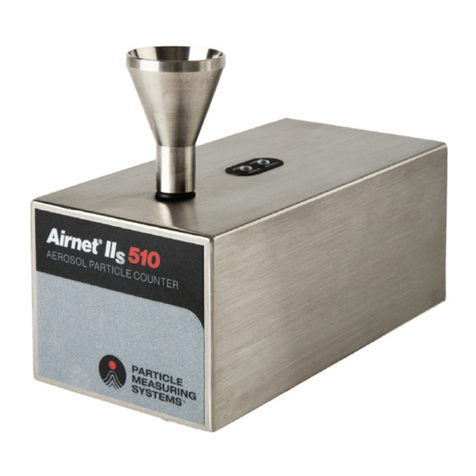
Spectris
Spectris Particle Measuring Systems Airnet II 301 Operation manual

Lamy Rheology
Lamy Rheology FIRST PLUS LR user manual

Navman
Navman A300 Sport.Tool user guide
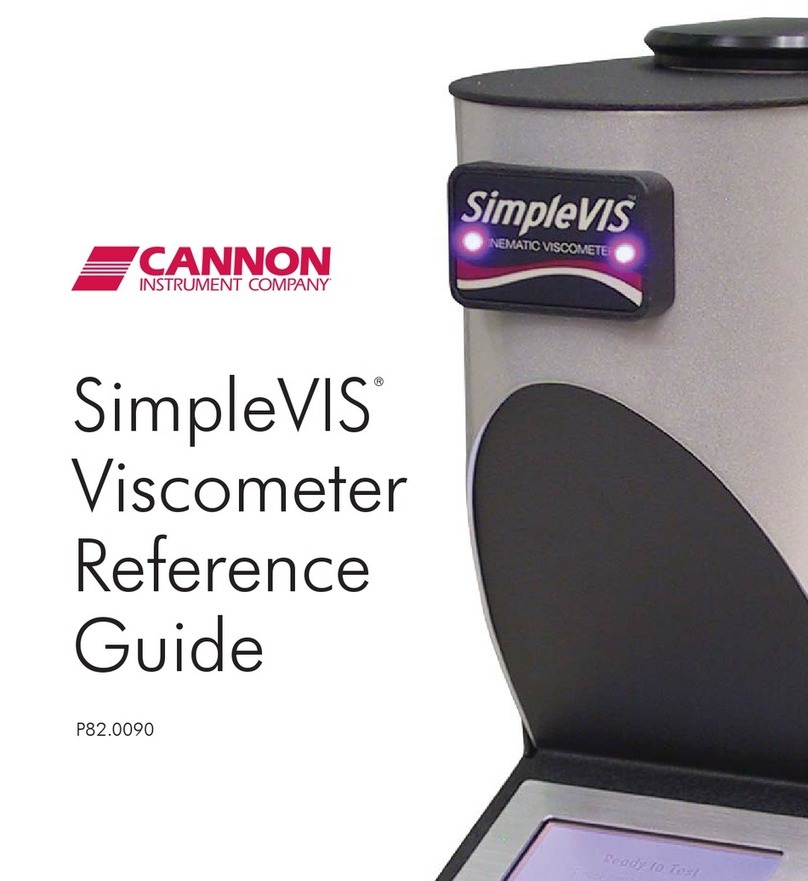
Cannon
Cannon SimpleVIS reference guide
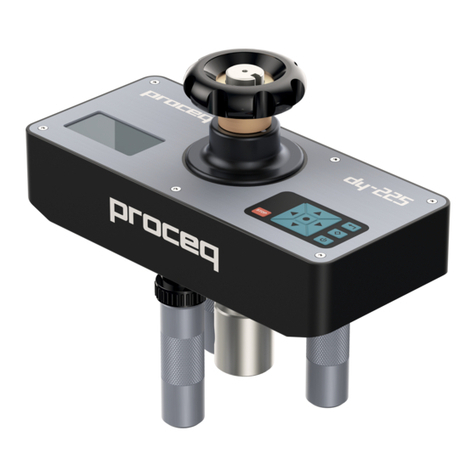
Proceq
Proceq DY-2 series operating instructions

Hanna Instruments
Hanna Instruments HI 96700 instruction manual
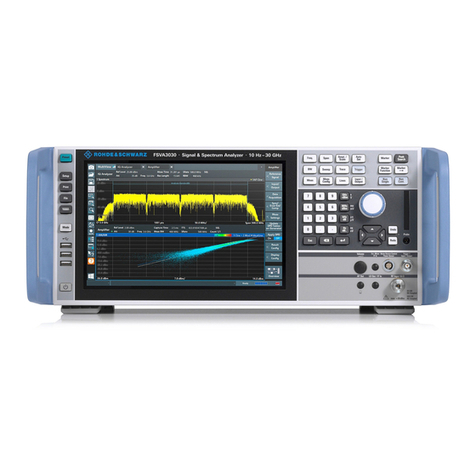
R&S
R&S FSVA3000 Series Getting started

Industrial Scientific
Industrial Scientific GasBadge Pro Quick start guides
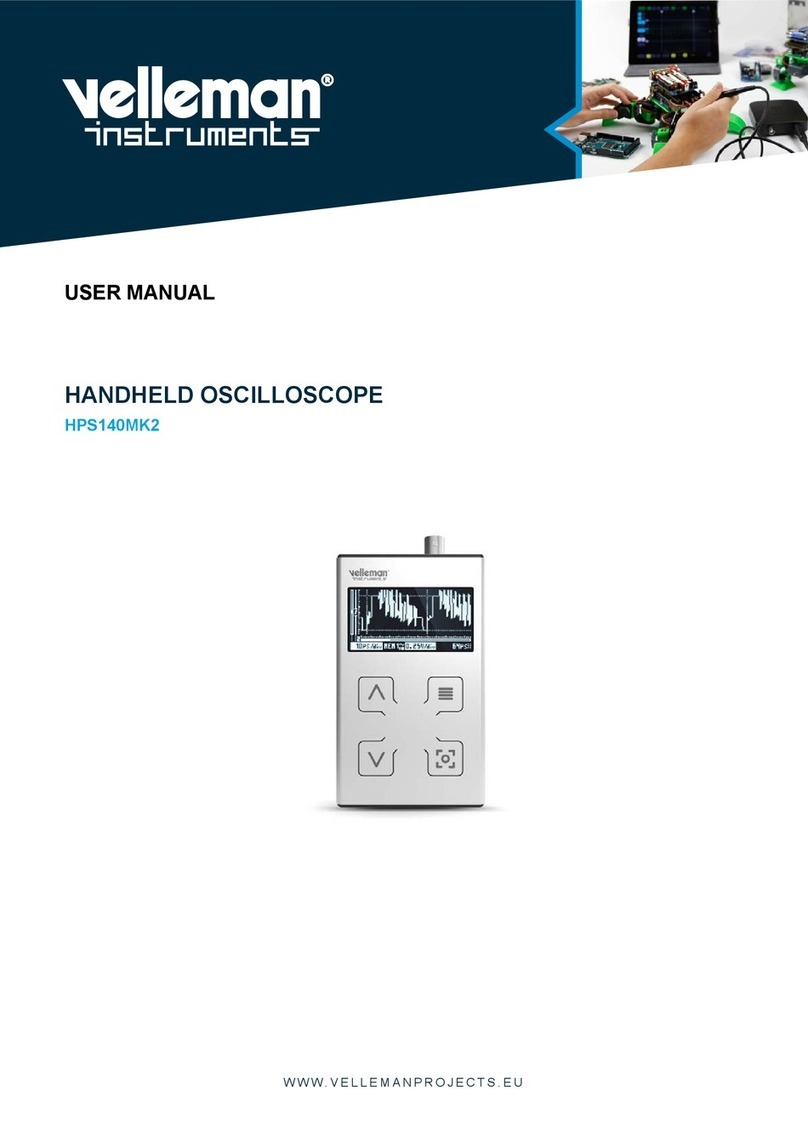
Velleman Instruments
Velleman Instruments HPS140MK2 user manual
